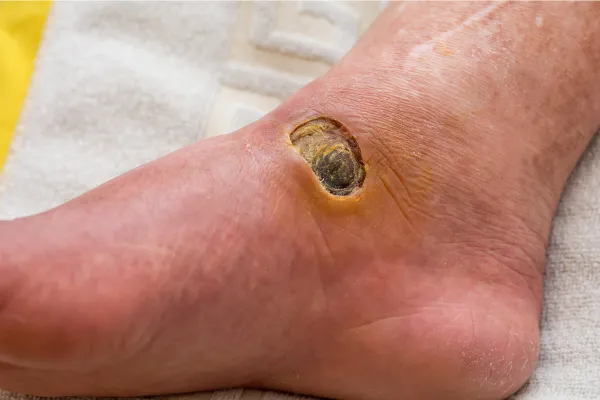
Understanding Diabetic Foot Ulcers: Types, Symptoms, and Treatment Options
Diabetic foot ulcers are among the most serious complications faced by individuals with diabetes, affecting approximately 15% of diabetic patients at some point in their lives. These open sores or wounds commonly occur on the bottom of the foot and can be extremely difficult to treat if not addressed early. If neglected, diabetic foot ulcers can lead to infections, gangrene, and even result in amputation.
Understanding the different types of diabetic foot ulcers and available treatment options is vital for both prevention and effective care. In this comprehensive guide, we will delve into the causes, types, symptoms, and treatment options for diabetic foot ulcers, with a focus on why early intervention is key.
For more in-depth information on wound care, visit our [Comprehensive Ulcer and Wound Care in Chicago] blog at American Surgeon Group.
Causes of Diabetic Foot Ulcers
The development of diabetic foot ulcers is closely linked to two primary complications of diabetes: peripheral neuropathy and peripheral artery disease (PAD). These conditions both contribute to poor circulation and lack of sensation in the feet, which leads to skin breakdown and ulcer formation.
Peripheral Neuropathy: One of the most common complications of diabetes, peripheral neuropathy, occurs when prolonged high blood sugar levels cause damage to the nerves. This nerve damage results in a loss of sensation in the feet, meaning that cuts, blisters, or other minor injuries can go unnoticed. Over time, these unnoticed injuries can worsen, becoming deep ulcers.
Peripheral Artery Disease (PAD): Diabetes can also damage the blood vessels in the legs, leading to reduced blood flow. Without adequate circulation, even minor injuries or sores on the feet struggle to heal. A lack of oxygenated blood reaching the feet makes it easier for ulcers to form and harder for them to recover.
Hyperglycemia: Elevated blood sugar levels not only contribute to nerve damage and poor circulation, but they also impair the immune system’s ability to fight off infection. Diabetic foot ulcers are more prone to infection due to the body’s weakened ability to respond to bacterial invaders.
Types of Diabetic Foot Ulcers
Diabetic foot ulcers are typically classified into three categories based on their underlying cause: neuropathic, ischemic, and neuroischemic ulcers. Each type has distinct characteristics and requires a tailored treatment approach.
1. Neuropathic Ulcers
Neuropathic ulcers result from peripheral neuropathy, which causes loss of sensation in the feet. When patients cannot feel injuries, they may continue walking on wounds, exacerbating the damage. This type of ulcer usually occurs on weight-bearing areas of the foot, such as the heel, ball, or the tips of the toes. Because of the loss of sensation, patients may not notice these ulcers until they become severe.
Key characteristics:
Painless, due to nerve damage.
Often found on pressure points of the foot.
Surrounding skin may appear calloused.
Warm and dry due to normal blood circulation.
Treatment for neuropathic ulcers typically involves offloading (removing pressure from the ulcerated area), proper wound care, and managing blood sugar levels.
2. Ischemic Ulcers
Ischemic ulcers occur due to poor blood flow caused by peripheral artery disease (PAD). When blood flow to the lower extremities is compromised, tissues do not receive enough oxygen and nutrients, leading to skin breakdown and ulcer formation. Ischemic ulcers are usually located on the tips of the toes, around the toenails, or on the outer edges of the foot.
Key characteristics:
Extremely painful due to tissue death and lack of blood flow.
Cold, bluish, or discolored skin around the ulcer.
Slower to heal and prone to infection.
Treatment for ischemic ulcers focuses on improving blood flow, often through lifestyle changes, medications, or even surgical interventions such as bypass surgery or angioplasty. Advanced wound care and infection prevention are also crucial for managing ischemic ulcers.
3. Neuroischemic Ulcers
Neuroischemic ulcers are a combination of both neuropathy and ischemia, making them particularly challenging to treat. These ulcers are characterized by a loss of sensation along with poor blood circulation. As a result, patients may not feel the ulcer developing, and when it does, healing is much slower due to insufficient blood flow.
Key characteristics:
Little to no sensation around the ulcer due to neuropathy.
Cold and discolored skin around the wound due to poor circulation.
Increased risk of infection and gangrene.
Treatment for neuroischemic ulcers is more complex and often involves a combination of treatments to both address the loss of sensation and improve circulation. This may include a combination of offloading, advanced wound dressings, and potentially surgical interventions.
Symptoms and Stages of Diabetic Foot Ulcers
Diabetic foot ulcers go through several stages, each requiring different levels of care. Recognizing the symptoms and understanding the progression of these ulcers is crucial to getting early treatment.
Common symptoms include:
Redness, swelling, or warmth around the wound.
Fluid drainage or pus, indicating infection.
Blackened or dead tissue (necrosis) around the wound edges, indicating severe tissue damage.
Pain (in the case of ischemic or neuroischemic ulcers) or numbness (in the case of neuropathic ulcers).
Stages of diabetic foot ulcers:
Callused Skin or Blisters: Ulcers often start with calluses or blisters on high-pressure areas of the foot.
Skin Breakdown: As the skin breaks down, a small open sore forms. This is the early stage of the ulcer.
Infection: If untreated, bacteria can invade the ulcer, causing infection. Signs include increased warmth, redness, and drainage.
Deep Tissue Involvement: The ulcer may extend through the skin and into deeper tissues, including muscles and bones. This is a severe stage and requires immediate medical attention.
Treatment Options for Diabetic Foot Ulcers
Treating diabetic foot ulcers involves a comprehensive approach to address both the wound itself and the underlying conditions that caused it. The goals of treatment are to promote healing, prevent infection, and reduce the risk of complications such as amputation.
1. Offloading
Offloading is one of the most important treatments for diabetic foot ulcers, particularly neuropathic ulcers. This technique involves reducing pressure on the ulcerated area, which helps prevent further damage and allows the wound to heal. Offloading can be achieved through various methods:
Custom-made shoes or inserts: These help redistribute pressure away from the ulcer.
Casts or braces: In some cases, patients may require a cast or a special walking boot to fully offload the pressure from the foot.
Wheelchairs or crutches: In severe cases, patients may need to avoid walking altogether to prevent further damage.
2. Debridement
Debridement involves the removal of dead or infected tissue from the ulcer to promote healing. By clearing away necrotic tissue, debridement helps create a cleaner environment for the wound to heal. There are several methods of debridement, including:
Surgical debridement: A healthcare provider uses surgical tools to remove dead tissue.
Enzymatic debridement: Special enzymes are applied to the wound to dissolve dead tissue.
Autolytic debridement: The body’s own enzymes are encouraged to break down dead tissue with the help of special wound dressings.
3. Advanced Wound Dressings
The type of dressing used for a diabetic foot ulcer plays a significant role in the healing process. Advanced wound dressings help maintain a moist environment, protect the wound from infection, and promote faster healing. Some common types of advanced dressings include:
Hydrocolloid dressings: These dressings help keep the wound moist and protect against infection.
Foam dressings: Absorbent foam dressings are ideal for ulcers that produce a lot of drainage.
Antimicrobial dressings: Dressings that contain silver or iodine can help reduce the risk of infection.
4. Surgical Interventions
In more severe cases, surgery may be required to treat diabetic foot ulcers. Surgical interventions are typically considered when conservative treatments fail or when there is significant tissue damage or infection. Common surgical treatments include:
Wound closure: In cases where the ulcer is large, a surgeon may close the wound with stitches or a skin graft.
Improving blood flow: For ischemic ulcers, surgeries such as angioplasty or bypass surgery can help improve blood circulation to the foot.
Amputation: In the most severe cases, amputation may be necessary to prevent the spread of infection and save the patient’s life.
Preventing Diabetic Foot Ulcers
Prevention is the most effective strategy for managing diabetic foot ulcers. By taking proactive steps to care for your feet, you can significantly reduce your risk of developing an ulcer.
Key prevention strategies include:
Regular foot check-ups: Have your feet examined by a healthcare professional regularly to catch any issues early.
Wearing proper footwear: Choose well-fitting shoes that protect your feet from injury and help distribute pressure evenly.
Managing blood sugar levels: Keeping your blood sugar under control is essential for preventing complications like neuropathy and poor circulation.
Daily foot care routine: Inspect your feet daily for cuts, blisters, or other injuries, and keep your skin clean and moisturized.
Conclusion
Diabetic foot ulcers are a serious complication of diabetes, but with early detection and proper treatment, they can be managed effectively. By understanding the different types of ulcers, recognizing the symptoms, and seeking prompt care, patients with diabetes can reduce their risk of serious complications.
At American Surgeon Group, we specialize in comprehensive diabetic ulcer care. If you are concerned about a foot ulcer, don’t wait—early intervention is critical. Contact us today to schedule a consultation, and visit our [Comprehensive Ulcer and Wound Care in Chicago] blog for more information.
